AMD Zen 2 Microarchitecture Analysis: Ryzen 3000 and EPYC Rome
by Dr. Ian Cutress on June 10, 2019 7:22 PM EST- Posted in
- CPUs
- AMD
- Ryzen
- EPYC
- Infinity Fabric
- PCIe 4.0
- Zen 2
- Rome
- Ryzen 3000
- Ryzen 3rd Gen
CCX Size
Moving down in node size brings up a number of challenges in the core and beyond. Even disregarding power and frequency, the ability to put structures into silicon and then integrate that silicon into the package, as well as providing power to the right parts of the silicon through the right connections becomes an exercise in itself. AMD gave us some insight into how 7nm changed some of its designs, as well as the packaging challenges therein.
A key metric given up by AMD relates to the core complex: four cores, the associated core structures, and then L2 and L3 caches. With 12nm and the Zen+ core, AMD stated that a single core complex was ~60 square millimeters, which separates into 44mm2 for the cores and 16mm2 for the 8MB of L3 per CCX. Add two of these 60mm2 complexes with a memory controller, PCIe lanes, four IF links, and other IO, and a Zen+ zeppelin die was 213 mm2 in total.
For Zen 2, a single chiplet is 74mm2, of which 31.3 mm2 is a core complex with 16 MB of L3. AMD did not breakdown this 31.3 number into cores and L3, but one might imagine that the L3 might be approaching 50% of that number. The reason the chiplet is so much smaller is that it doesn’t need memory controllers, it only has one IF link, and has no IO, because all of the platform requirements are on the IO die. This allows AMD to make the chiplets extremely compact. However if AMD intends to keep increasing the L3 cache, we might end up with most of the chip as L3.
Overall however, AMD has stated that the CCX (cores plus L3) has decreased in size by 47%. That is showing great scaling, especially if the +15% raw instruction throughput and increased frequency comes into play. Performance per mm2 is going to be a very exciting metric.
Packaging
With Matisse staying in the AM4 socket, and Rome in the EPYC socket, AMD stated that they had to make some bets on its packaging technology in order to maintain compatibility. Invariably some of these bets end up being tradeoffs for continual support, however AMD believes that the extra effort has been worth the continued compatibility.
One of the key points AMD spoke about with relation to packaging is how each of the silicon dies are attached to the package. In order to enable a pin-grid array desktop processor, the silicon has to be affixed to the processor in a BGA fashion. AMD stated that due to the 7nm process, the bump pitch (the distance between the solder balls on the silicon die and package) reduced from 150 microns on 12nm to 130 microns on 7nm. This doesn’t sound like much, however AMD stated that there are only two vendors in the world with technology sufficient to do this. The only alternative would be to have a bigger bit of silicon to support a larger bump pitch, ultimately leading to a lot of empty silicon (or a different design paradigm).
One of the ways in order to enable the tighter bump pitch is to adjust how the bumps are processed on the underside of the die. Normally a solder bump on a package is a blob/ball of lead-free solder, relying on the physics of surface tension and reflow to ensure it is consistent and regular. In order to enable the tighter bump pitches however, AMD had to move to a copper pillar solder bump topology.
In order to enable this feature, copper is epitaxially deposited within a mask in order to create a ‘stand’ on which the reflow solder sits. Due to the diameter of the pillar, less solder mask is needed and it creates a smaller solder radius. AMD also came across another issue, due to its dual die design inside Matisse: if the IO die uses standard solder bump masks, and the chiplets use copper pillars, there needs to be a level of height consistency for integrated heat spreaders. For the smaller copper pillars, this means managing the level of copper pillar growth.
AMD explained that it was actually easier to manage this connection implementation than it would be to build different height heatspreaders, as the stamping process used for heatspreaders would not enable such a low tolerance. AMD expects all of its 7nm designs in the future to use the copper pillar implementation.
Routing
Beyond just putting the silicon onto the organic substrate, that substrate has to manage connections between the die and externally to the die. AMD had to increase the number of substrate layers in the package to 12 for Matisse in order to handle the extra routing (no word on how many layers are required in Rome, perhaps 14). This also becomes somewhat complicated for single core chiplet and dual core chiplet processors, especially when testing the silicon before placing it onto the package.
From the diagram we can clearly see the IF links from the two chiplets going to the IO die, with the IO die also handling the memory controllers and what looks like power plane duties as well. There are no in-package links between the chiplets, in case anyone was still wondering: the chiplets have no way of direct communication – all communication between chiplets is handled through the IO die.
AMD stated that with this layout they also had to be mindful of how the processor was placed in the system, as well as cooling and memory layout. Also, when it comes to faster memory support, or the tighter tolerances of PCIe 4.0, all of this also needs to be taken into consideration as provide the optimal path for signaling without interference from other traces and other routing.


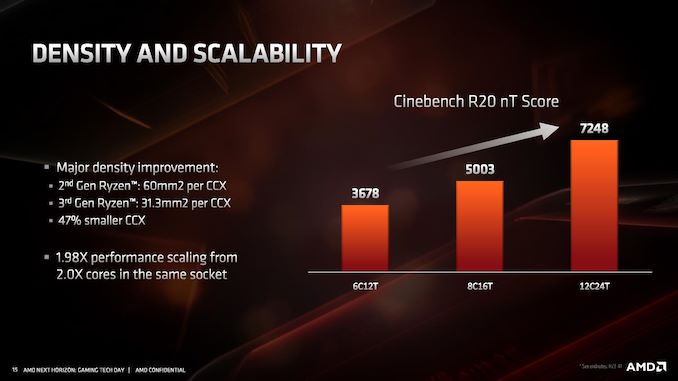
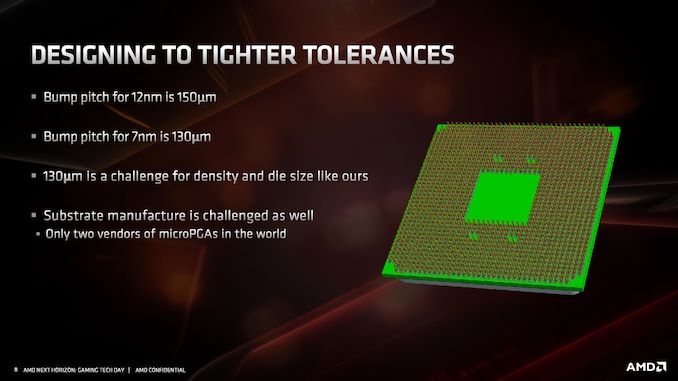
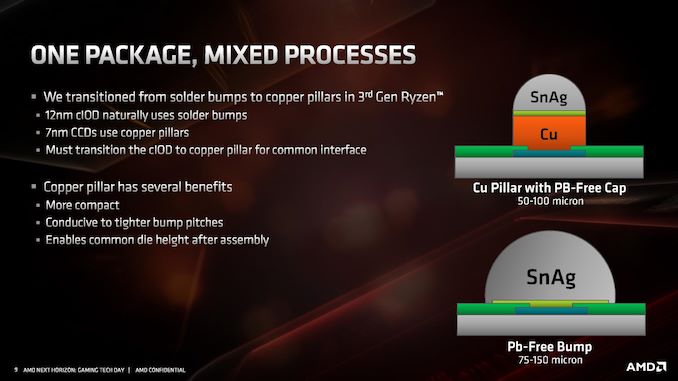
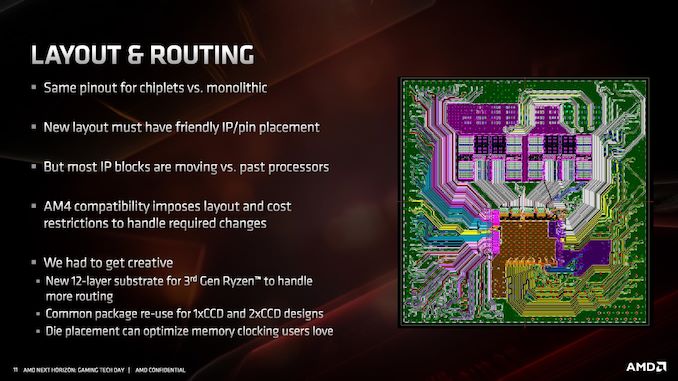
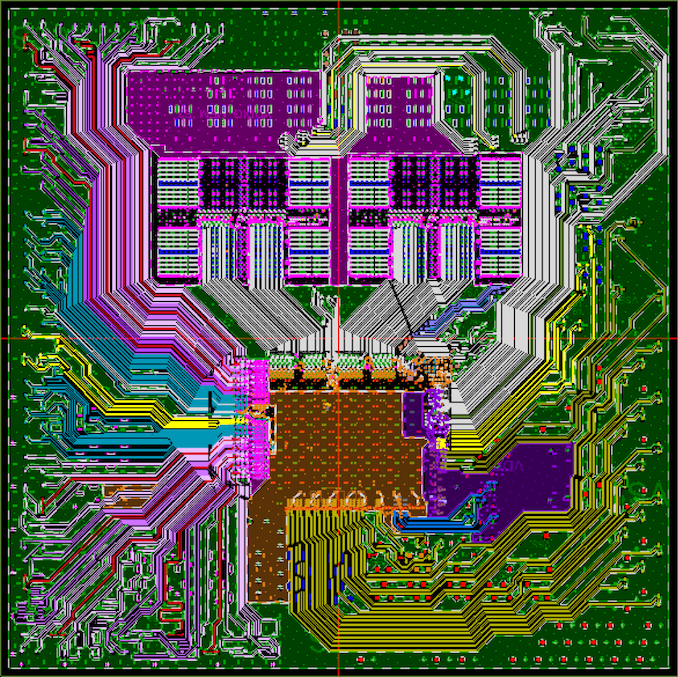








216 Comments
View All Comments
jamescox - Saturday, June 22, 2019 - link
You seem to just be trying to spread FUD. Also, you don’t seem to know how long a nanosecond is. The CCX to CCX latency can cause slower performance for some badly written or or badly optimized multithreaded code, but it is on such a fine scale that it would just effect the average frame rate. It isn’t going to cause stuttering as you describe.The stuttering you describe could be caused by a huge number of things. It could be the gpu or cpu thermally throttling due to inadequate cooling. If the gpu utilization goes down low, that could be due to the game using more memory than the gpu has available. That will slow to a crawl while assets are loaded across the pci express bus. So, if anyone is actually having this problem, check your temperatures, check your memory usage (both cpu and gpu), then maybe look for driver / OS issues.
playtech1 - Wednesday, June 12, 2019 - link
Good products and good prices.Knock-out blow though? I don't think so for the consumer and gaming space, as I can buy a 9900 today for a fairly small premium over the price of a 3800x and get basically the same performance.
The 12 and 16 core chips look more difficult for Intel to respond to though, given how expensive its HEDT line is (and I say that as an owner of a 7860x).
Atari2600 - Wednesday, June 12, 2019 - link
Yeah, power and thermals are not so important in consumer/game space.In server/HPC, Intel is in deep crap.
Phynaz - Wednesday, June 12, 2019 - link
Bahahaha. No.eva02langley - Thursday, June 13, 2019 - link
Phhh... are you ban from WCCFtech?Gastec - Wednesday, June 19, 2019 - link
I guess I'm neither consumer nor gamer with my i7-860 and GTX 670, G502, G110 and G13. I bought the Logitech G13 just to type better comments on Tweeter :PGastec - Wednesday, June 19, 2019 - link
I also turn OFF RGB whenever I can, anti-cosumerism and anti-social is written on my forehead and everyone is pointing at me on the woke streets.just4U - Thursday, June 13, 2019 - link
I'd say it's a substantial blow to Intel. One of the reasons I picked up a 2700x was the cooler, which is pretty damn good overall.. and the buy in was substantially lower. The 3700x-3800x will only add to that incentive with increased performance (most will likely not even notice..)Drop in the 12-16 core processors (provided there are no tradeoffs for those additional cores..) make the 9900k unappealing on all fronts. The 9700K was a totally unappealing product with it's 8c/8t package..already and after this launch won't make sense at all.
Gastec - Thursday, June 20, 2019 - link
Core i9-9900 I presume. Nowhere to be found for sale in Mordor. Only found one on Amazon.com for $439.99 reduced from $524.95, sold by "Intel" whomever that scammer is.Hamza12786 - Thursday, June 13, 2019 - link
I Like This Site.Also Checkout<a href"https://www.khanzadatech.com/2019/05/zong-unlimite... Unlimited Free Internet</a>